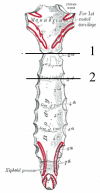Bone healing after median sternotomy: a comparison of two hemostatic devices
- PMID: 21106051
- PMCID: PMC3001423
- DOI: 10.1186/1749-8090-5-117
Bone healing after median sternotomy: a comparison of two hemostatic devices
Abstract
Background: Bone wax is traditionally used as part of surgical procedures to prevent bleeding from exposed spongy bone. It is an effective hemostatic device which creates a physical barrier. Unfortunately it interferes with subsequent bone healing and increases the risk of infection in experimental studies. Recently, a water-soluble, synthetic, hemostatic compound (Ostene®) was introduced to serve the same purpose as bone wax without hampering bone healing. This study aims to compare sternal healing after application of either bone wax or Ostene®.
Methods: Twenty-four pigs were randomized into one of three treatment groups: Ostene®, bone wax or no hemostatic treatment (control). Each animal was subjected to midline sternotomy. Either Ostene® or bone wax was applied to the spongy bone surfaces until local hemostasis was ensured. The control group received no hemostatic treatment. The wound was left open for 60 min before closing to simulate conditions alike those of cardiac surgery. All sterni were harvested 6 weeks after intervention.Bone density and the area of the bone defect were determined with peripheral quantitative CT-scanning; bone healing was displayed with plain X-ray and chronic inflammation was histologically assessed.
Results: Both CT-scanning and plain X-ray disclosed that bone healing was significantly impaired in the bone wax group (p < 0.01) compared with the other two groups, and the former group had significantly more chronic inflammation (p < 0.01) than the two latter.
Conclusion: Bone wax inhibits bone healing and induces chronic inflammation in a porcine model. Ostene® treated animals displayed bone healing characteristics and inflammatory reactions similar to those of the control group without application of a hemostatic agent.
Figures







Similar articles
-
The influence of hemostatic agents on bone healing after sternotomy in a porcine model.Ann Thorac Surg. 2015 Mar;99(3):1005-11. doi: 10.1016/j.athoracsur.2014.10.016. Epub 2015 Jan 16. Ann Thorac Surg. 2015. PMID: 25601654
-
Effect of hemostatic material on sternal healing after cardiac surgery.Ann Thorac Surg. 2014 Jan;97(1):153-60. doi: 10.1016/j.athoracsur.2013.08.030. Epub 2013 Oct 8. Ann Thorac Surg. 2014. PMID: 24119983 Clinical Trial.
-
The effects of a soluble polymer and bone wax on sternal healing in an animal model.Ann Thorac Surg. 2008 May;85(5):1776-80. doi: 10.1016/j.athoracsur.2007.11.042. Ann Thorac Surg. 2008. PMID: 18442583
-
Bone Wax in Neurosurgery: A Review.World Neurosurg. 2018 Aug;116:72-76. doi: 10.1016/j.wneu.2018.04.222. Epub 2018 May 9. World Neurosurg. 2018. PMID: 29753076 Review.
-
Bone wax: a foreign body/giant cell reaction in the foot.Foot Ankle Spec. 2013 Jun;6(3):236-8. doi: 10.1177/1938640013484797. Epub 2013 Apr 2. Foot Ankle Spec. 2013. PMID: 23548587 Review.
Cited by
-
Computed Tomography Imaging Assessment of the Effect of Vancomycin Paste on Poststernotomy Healing.Int J Gen Med. 2021 Dec 2;14:9287-9296. doi: 10.2147/IJGM.S343124. eCollection 2021. Int J Gen Med. 2021. PMID: 34880667 Free PMC article.
-
Comparative Performance of Calcium Phosphate Grafts and Iliac Crest Autograft in Posterolateral Spinal Fusion in Rabbits.JOR Spine. 2025 Jul 30;8(3):e70101. doi: 10.1002/jsp2.70101. eCollection 2025 Sep. JOR Spine. 2025. PMID: 40741218 Free PMC article.
-
Does bone wax make sense in off-pump coronary surgery? A prospective randomized study.Kardiochir Torakochirurgia Pol. 2023 Jun;20(2):67-71. doi: 10.5114/kitp.2023.129551. Epub 2023 Jul 26. Kardiochir Torakochirurgia Pol. 2023. PMID: 37564968 Free PMC article.
-
Topical haemostatic agents in surgery.Br J Surg. 2024 Jan 3;111(1):znad361. doi: 10.1093/bjs/znad361. Br J Surg. 2024. PMID: 38156466 Free PMC article. No abstract available.
-
In vivo assessment of new resorbable PEG-PPG-PEG copolymer/starch bone wax in bone healing and tissue reaction of bone defect in rabbit model.J Mater Sci Mater Med. 2014 Sep;25(9):2131-9. doi: 10.1007/s10856-014-5249-6. Epub 2014 Jun 10. J Mater Sci Mater Med. 2014. PMID: 24913421
References
-
- Johnson P, Fromm D. Effects of bone wax on bacterial clearance. Surgery. 1981;89(2):206–9. - PubMed
-
- Nelson DR, Buxton TB, Luu QN, Rissing JP. The promotional effect of bone wax on experimental Staphylococcus aureus osteomyelitis. J Thorac Cardiovasc Surg. 1990;99(6):977–80. - PubMed
-
- Alberius P, Klinge B, Sjogren S. Effects of bone wax on rabbit cranial bone lesions. J Craniomaxillofac Surg. 1987;15(2):63–7. - PubMed
Publication types
MeSH terms
Substances
LinkOut - more resources
Full Text Sources

